
Phyllostachys is a genus of Asian bamboo in the grass family. Many of the species are found in central and southern China, with a few species in northern Indochina and in the Himalayas. Some of the species have become naturalized in parts of Asia, Australia, the Americas, and southern Europe.

Datura metel is a shrub-like annual or short-lived, shrubby perennial, commonly known in Europe as Indian Thornapple, Hindu Datura, or Metel and in the U.S.A. as Devil's Trumpet or Angel's Trumpet. Datura metel is naturalised in all the warmer countries of the world - notably in India, where it is known by the ancient, Sanskrit-derived, Hindi name धतूरा (dhatūra) -from which the genus name Datura is derived, and in Tamil as ஊமத்தை (ūmattai). The plant is cultivated worldwide, both as an ornamental and for its medicinal properties, the latter being due to its tropane alkaloid content. Like its hardier and smaller-flowered relative Datura stramonium, it is now of widespread occurrence, although showing a preference for warmer climates and of more attractive appearance. Datura metel was first described by Carl Linnaeus in 1753, but few botanically correct illustrations were made until after the New World was settled. The original home of the plant is now known to have been somewhere in the Americas, probably the Greater Antilles. As late as 1992 it was still being claimed that the plant was "...native probably to the mountainous regions of Pakistan or Afghanistan westward..." While there now remains no doubt that the species originated in the New World, evidence is mounting that it was introduced to the Indian subcontinent - whether by human agency or some chance natural event is not known - at an early date preceding by far the arrival of the first European explorers in the Americas.

The seven-colored tanager is a vulnerable species of bird in the family Thraupidae. It is endemic to forests in north-eastern Brazil. It resembles the overall greener green-headed tanager; a species confusingly known as the seven-coloured tanager (saíra-sete-cores) in Portuguese.
Walter Linsenmaier was a Swiss artist and entomologist. He was particularly known for his highly detailed illustrations of animals, plants, and insects which were widely published in magazines and books. He was also one of the 20th century's most important experts on the cuckoo wasp (Chrysididae) and described over 600 new species and subspecies of the insect. Linsenmaier was awarded an Honorary Doctorate from the University of Bern in 1982 in recognition of his scientific and artistic achievements and the Ernst Jünger Prize for Entomology from the State of Baden-Württemberg in 1992.
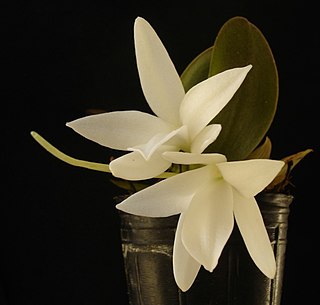
Aerangis fastuosa, commonly known as the 'Magnificent Aerangis', is a species of epiphytic orchid endemic to Madagascar. It is widespread across Madagascar, stretching from the eastern coastal forests across to the south and along the central plateau. Aerangis fastuosa belongs to the family Orchidaceae, substribe Aerangidinae.

Chrysis inaequalis is a species of cuckoo wasps. The species occurs in Central and Southern Europe and in the Near East. The head and the thorax are shiny metallic blue-green, while the abdomen is red. Adults grow up to 5–10 millimetres (0.20–0.39 in) long and can be encountered from late June to mid September, especially flying on sun-exposed walls, on rocks and on dead wood.

Semiarundinaria fastuosa, the Narihira bamboo, Narihira cane or Narihiradake, is a species of flowering plant in the grass family Poaceae, native to Japan. Growing to 7 m (23 ft) tall by 2 m (7 ft) broad, it is a vigorous, evergreen bamboo with dark green cylindrical canes and dense tufts of lanceolate, glossy green leaves, up to 20 cm (8 in) long.

Trichopteryx fastuosa is a species of moth of the family Geometridae first described by Inoue in 1958. It is found in Taiwan.

Lampetis fastuosa is a jewel beetle of the family Buprestidae.

Chrysolina fastuosa, also known as the dead-nettle leaf beetle, is a species of beetle from a family of Chrysomelidae found in Europe, Caucasus and northern Turkey.

Chrysis is a very large genus of cuckoo wasps. It is the largest genus in the family, including over 1,000 species, as large as the rest of the Chrysididae together. The generic name is derived from Greek chrysis, "gold vessel, gold-embroidered dress", and pays tribute to the brilliant metallic appearance of wasps in the genus.

Chrysidini is a very large tribe of cuckoo wasps in the subfamily Chrysidinae; this tribe contains more than half of all chrysidid species.
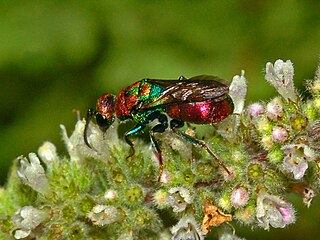
Hedychrum is a large genus of cuckoo wasps. With roughly 150 species, it is the second largest genus in the family; most species are from the Palaearctic, but they can be found in the Oriental, Afrotropical, Nearctic, and Neotropical regions. Their hosts are typically from the subfamily Philanthinae.
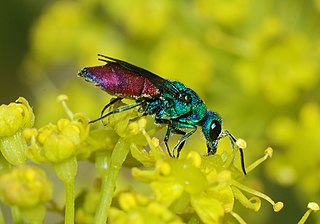
Chrysura is a genus of cuckoo wasps which parasitize megachilid bees. There are 117 species in Chrysura, all but 11 of which are found in the Palaearctic. The genus was described by Dahlbom in 1845, and the type species for the genus is Chrysura austriaca. It is the third largest genus in the family Chrysididae.

Inga fastuosa is a species of plant in the family Fabaceae. It is found in Brazil, the Caribbean, and Venezuela.

Arctotis fastuosa, called Monarch-of-the-veld, is a species of African plants in the daisy family, native to Namibia and South Africa. It has become naturalized on roadsides and in vacant urban lots in southern California.

Holopyga is a genus of cuckoo wasps.

Spinolia dallatorreana is a species of cuckoo wasps belonging to the subfamily Chrysidinae.
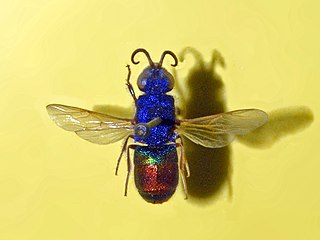
Chrysis comparata is a species of cuckoo wasps.
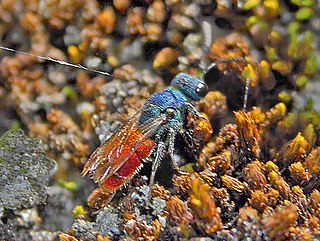
Chrysis ruddii, the ruby-tailed wasp, is a species of cuckoo wasps, an insects in the family Chrysididae.



















